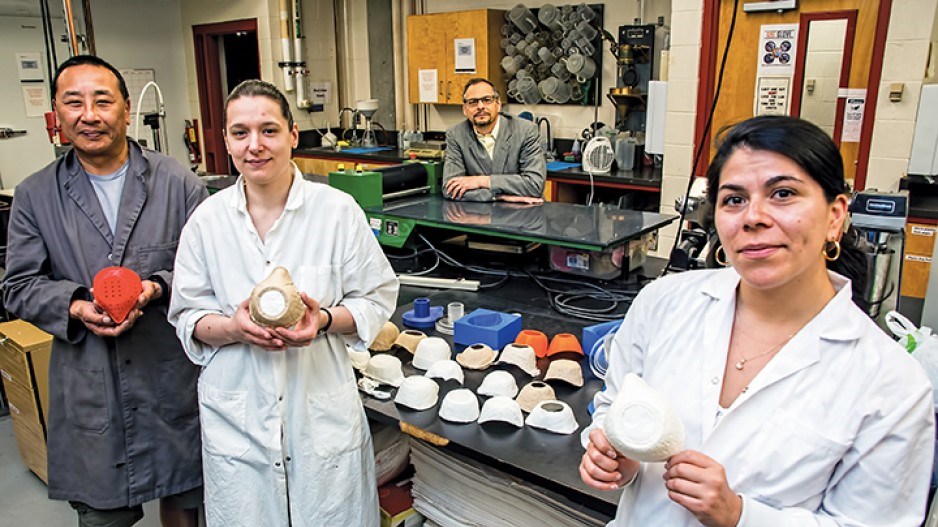While the rest of the B.C. economy has been locked down for much of March and April, Mustang Survival has been feverishly busy.
“With some of the big contracts we have, we are pretty much booked solid for six months plus,” said Mark Anderson, head of engineering at Mustang and chairman of the BC Apparel & Gear Association. “We’ve seen a lot of interest from smaller, non-hospital-type businesses that also need to protect their workers.”
Mustang, the Burnaby-based manufacturer of lifejackets and survival suits, began making hospital gowns after being contacted by Vancouver Coastal Health (VCH) in March.
And while supply-chain realities prevented all the ideas from coming to fruition – N95 face masks, for example, required specialized material no longer produced in Canada – the ability to supply locally sourced medical gowns has become brisk business and a new way for Mustang to dedicate itself to its mission of saving lives.
Today, the company’s manufacturing staff of 100 churns out about 700 units a day, with a goal of reaching 5,000 a week. To handle its VCH contract for 30,000 units and another deal with Ottawa for 150,000 units, Mustang is hiring to boost staffing to 150. In addition, it is working with the province to train workers with an on-site program that gets trainees certified and working within three to four weeks of starting, Anderson said.
He added that altering production has not been too difficult because most of the required machinery is already in place or easily available.
COVID-19 has completely altered the Canadian market for medical personal protective equipment (PPE). In a report published by Ottawa-based trade consultancy Allam Advisory Group earlier this month, officials say demand for products like face masks (both medical and non-medical) are expected to grow into a $3.5 billion market by next spring.
For B.C., that means up to 412 million masks that will need to come from somewhere, said company CEO and founder Omar Allam
He added that demand for gowns and visors is also booming as Canadian health workers encounter widespread PPE shortages.
Allam also noted that the federal and provincial governments have faced challenges meeting that sudden demand, especially in trying to acquire the goods through traditional import channels, usually from China.
According to May 21 Public Services and Procurement Canada data, most of the items ordered by Canadian authorities for fighting COVID-19, such as face shields, gloves, gowns, hand sanitizer, N95 respirators, surgical masks and ventilators, have not been received.
For example, the statistics show that, as of May 19, Canada had received only 11.8 million N95 respirators out of the 104.6 million it had ordered. Worse, of that 11.8 million, 10.9 million were part of a single order from one supplier in which 9.8 million units were deemed unfit under Canadian medical standards.
The situation is similarly dire on other PPE fronts. Canada has received only 1.4 million gowns out of the 133.3 million it has ordered, as well as 14.2 million pairs of medical gloves out of 1.1 billion pairs ordered.
With China now pushing stringent export limitations on PPE, Allam said the path is open for a domestic producer to step in.
But he added that some raw materials aren’t available within Canada and need to be imported.
That’s why the solution to Canada’s massive PPE demand won’t be resolved completely through local manufacturing. Canadian companies need to make sure they have a plan to procure other foreign raw material sources that are robust and can help supply local manufacturing know-how.
One solution may be brewing at the University of British Columbia, however.
The school’s BioProducts Institute recently unveiled prototypes of N95 masks that can be produced from B.C.-sourced wood fibre, and one of the two prototypes comes with an experimental filter also made with local wood fibre.
“To me, this project is the tip of the iceberg,” said Orlando Rojas, scientific director at the BioProducts Institute. “This could be a launch pad to discovering more uses of local wood fibres for material needs. Filtration is just one example where fibres can be used, and the fibres we have here in B.C. are plenty.”
Rojas added that while it may take a while for Can-Mask’s wood fibre technology to be commercialized, the potential of the new material to meet the need for B.C. and Canadian PPE demand is almost a “two-birds one-stone” solution, given that it would also help revitalize the province’s struggling wood-products sector.
Mustang’s Anderson said the COVID-19 crisis has placed much attention on local manufacturing capabilities in B.C.
The renewed focus may spur a more long-term trend to return some manufacturing capacity to Canada through government investment – something that can help not only the local economy but also its supply-chain stability, Anderson said.
“I don’t think people have any clue we have this capability here, to be honest,” he said. “At the BC Apparel & Gear Association, one of the burning issues has been bringing in new talent – and a major challenge is a lack of awareness. Kids, when going through school, don’t think of apparel and gear as a place to work, when it’s quite significant in this province and known worldwide.
“Definitely, I think the awareness will change for local manufacturing, 100%. And if cost is a challenge, we can look to technology to solve those problems with things like automation. So this attention is super-positive; it’s reinvigorating for the economy, it creates jobs and all the net positives from that. It does require some investment … but we have tons of capabilities. We just need to smarten up and stop sending work away.”




